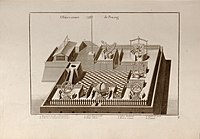Beijing Ancient Observatory
 On the grounds of the Beijing Ancient Observatory with a bronze bust of the astronomer and mathematician Guo Shoujing in the foreground. | |
| Location | Jianguomen Subdistrict, Dongcheng, Beijing, PRC |
|---|---|
| Coordinates | 39°54′22″N 116°25′41″E / 39.9061°N 116.4281°E |
| Website | www |
| | |
The Beijing Ancient Observatory (
As one of the oldest
History


It was said that in 1227, the Jin dynasty transferred the ancient astronomical instruments from Kaifeng to the first observatory in Beijing. In 1279, the succeeding Mongols under Kublai Khan built a new observatory just north of the current observatory. Kublai Khan made his chief adviser of hydraulics, mathematics and astronomy, Guo Shoujing, director of the observatory in 1283 after the death of Guo's friend and predecessor Zhang Wenqian.[2] After the Mongols, Zhu Yuanzhang, the founding Ming Emperor, transferred the instruments from Beijing to Nanjing. When the Yongle Emperor came to power, he had craftsmen make copies of the instruments in Nanjing and sent them to the Beijing observatory.
The current observatory was completed in 1442. It assisted the Ming and Qing astronomers in their observation reports for the Emperor. As he was considered the "
During the later stages of the Qing dynasty, members of the
Access and nearby attractions
The Beijing Ancient Observatory is located just south of
See also
- Chinese astronomy
- History of Beijing
- Ferdinand Augustin Hallerstein, creator of some of the instruments
- Ignaz Kögler, creator of some of the instruments
- Ferdinand Verbiest, creator of some of the instruments
- List of astronomical observatories
- List of Jesuit sites
References
- ^ "The Observatory, Peking". Cambridge Digital Library. Retrieved 3 July 2015.
- ^ O'Connor, J. J.; Robertson, E. F. "Guo Shoujing". St Andrews University. Retrieved 3 July 2015.
- ^ [1] Archived October 13, 2008, at the Wayback Machine
- ^ [2] Archived August 19, 2008, at the Wayback Machine

